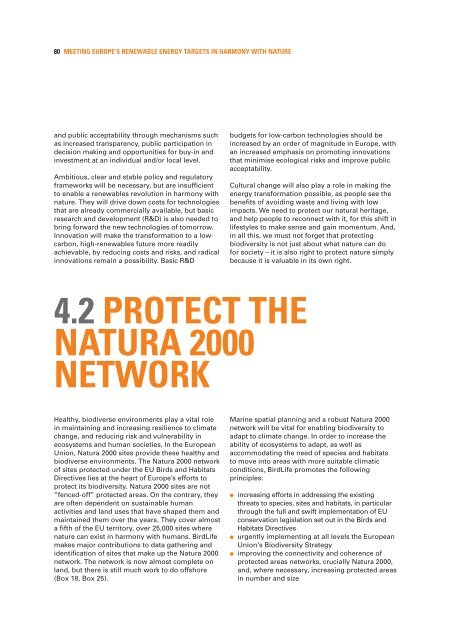Meeting Europe's renewable energy targets in harmony with - RSPB
Meeting Europe's renewable energy targets in harmony with - RSPB
Meeting Europe's renewable energy targets in harmony with - RSPB
Create successful ePaper yourself
Turn your PDF publications into a flip-book with our unique Google optimized e-Paper software.
80 MEETING EUROPE’S RENEWABLE ENERGY TARGETS IN HARMONY WITH NATURE<br />
and public acceptability through mechanisms such<br />
as <strong>in</strong>creased transparency, public participation <strong>in</strong><br />
decision mak<strong>in</strong>g and opportunities for buy-<strong>in</strong> and<br />
<strong>in</strong>vestment at an <strong>in</strong>dividual and/or local level.<br />
Ambitious, clear and stable policy and regulatory<br />
frameworks will be necessary, but are <strong>in</strong>sufficient<br />
to enable a <strong>renewable</strong>s revolution <strong>in</strong> <strong>harmony</strong> <strong>with</strong><br />
nature. They will drive down costs for technologies<br />
that are already commercially available, but basic<br />
research and development (R&D) is also needed to<br />
br<strong>in</strong>g forward the new technologies of tomorrow.<br />
Innovation will make the transformation to a lowcarbon,<br />
high-<strong>renewable</strong>s future more readily<br />
achievable, by reduc<strong>in</strong>g costs and risks, and radical<br />
<strong>in</strong>novations rema<strong>in</strong> a possibility. Basic R&D<br />
budgets for low-carbon technologies should be<br />
<strong>in</strong>creased by an order of magnitude <strong>in</strong> Europe, <strong>with</strong><br />
an <strong>in</strong>creased emphasis on promot<strong>in</strong>g <strong>in</strong>novations<br />
that m<strong>in</strong>imise ecological risks and improve public<br />
acceptability.<br />
Cultural change will also play a role <strong>in</strong> mak<strong>in</strong>g the<br />
<strong>energy</strong> transformation possible, as people see the<br />
benefits of avoid<strong>in</strong>g waste and liv<strong>in</strong>g <strong>with</strong> low<br />
impacts. We need to protect our natural heritage,<br />
and help people to reconnect <strong>with</strong> it, for this shift <strong>in</strong><br />
lifestyles to make sense and ga<strong>in</strong> momentum. And,<br />
<strong>in</strong> all this, we must not forget that protect<strong>in</strong>g<br />
biodiversity is not just about what nature can do<br />
for society – it is also right to protect nature simply<br />
because it is valuable <strong>in</strong> its own right.<br />
4.2 PROTECT THE<br />
NATURA 2000<br />
NETWORK<br />
Healthy, biodiverse environments play a vital role<br />
<strong>in</strong> ma<strong>in</strong>ta<strong>in</strong><strong>in</strong>g and <strong>in</strong>creas<strong>in</strong>g resilience to climate<br />
change, and reduc<strong>in</strong>g risk and vulnerability <strong>in</strong><br />
ecosystems and human societies. In the European<br />
Union, Natura 2000 sites provide these healthy and<br />
biodiverse environments. The Natura 2000 network<br />
of sites protected under the EU Birds and Habitats<br />
Directives lies at the heart of Europe’s efforts to<br />
protect its biodiversity. Natura 2000 sites are not<br />
“fenced-off” protected areas. On the contrary, they<br />
are often dependent on susta<strong>in</strong>able human<br />
activities and land uses that have shaped them and<br />
ma<strong>in</strong>ta<strong>in</strong>ed them over the years. They cover almost<br />
a fifth of the EU territory, over 25,000 sites where<br />
nature can exist <strong>in</strong> <strong>harmony</strong> <strong>with</strong> humans. BirdLife<br />
makes major contributions to data gather<strong>in</strong>g and<br />
identification of sites that make up the Natura 2000<br />
network. The network is now almost complete on<br />
land, but there is still much work to do offshore<br />
(Box 18, Box 25).<br />
Mar<strong>in</strong>e spatial plann<strong>in</strong>g and a robust Natura 2000<br />
network will be vital for enabl<strong>in</strong>g biodiversity to<br />
adapt to climate change. In order to <strong>in</strong>crease the<br />
ability of ecosystems to adapt, as well as<br />
accommodat<strong>in</strong>g the need of species and habitats<br />
to move <strong>in</strong>to areas <strong>with</strong> more suitable climatic<br />
conditions, BirdLife promotes the follow<strong>in</strong>g<br />
pr<strong>in</strong>ciples:<br />
●<br />
●<br />
●<br />
<strong>in</strong>creas<strong>in</strong>g efforts <strong>in</strong> address<strong>in</strong>g the exist<strong>in</strong>g<br />
threats to species, sites and habitats, <strong>in</strong> particular<br />
through the full and swift implementation of EU<br />
conservation legislation set out <strong>in</strong> the Birds and<br />
Habitats Directives<br />
urgently implement<strong>in</strong>g at all levels the European<br />
Union's Biodiversity Strategy<br />
improv<strong>in</strong>g the connectivity and coherence of<br />
protected areas networks, crucially Natura 2000,<br />
and, where necessary, <strong>in</strong>creas<strong>in</strong>g protected areas<br />
<strong>in</strong> number and size
















